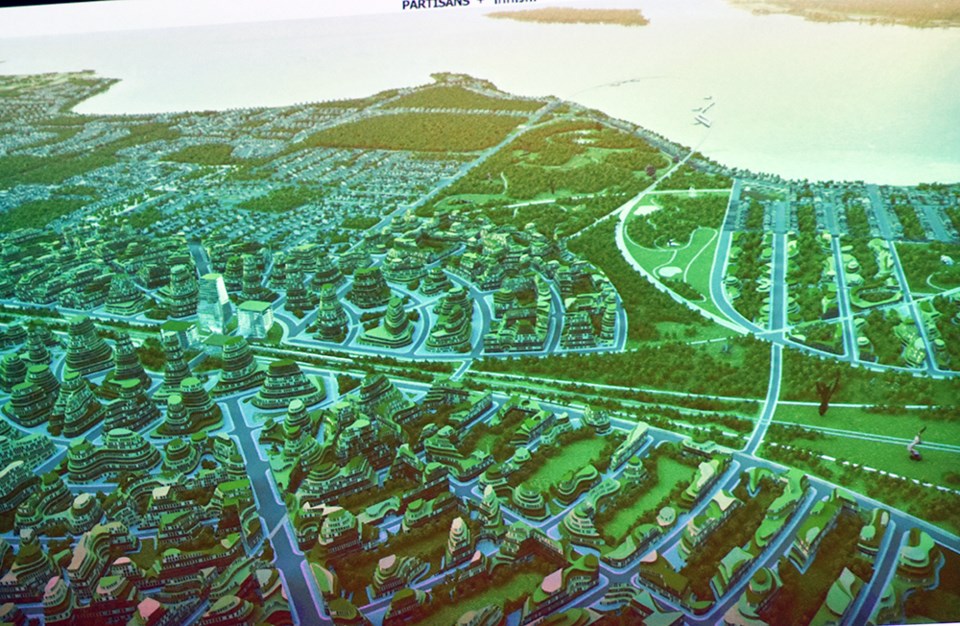On Monday, the Town of Innisfil announced that the Ministry of Municipal Affairs and Housing has granted a Ministerial Zoning Order (MZO) for the Mobility Orbit, a planned high-density community to be built around a new GO train station on Innisfil’s Line 6.
Environmental groups like the Rescue Lake Simcoe Coalition (RLSC) are already sounding the alarm.
RLSC Executive Director Claire Malcolmson expressed concern that the MZO does not include any reference to the Lake Simcoe Protection Plan, despite requests from both the Coalition and the Town of Innisfil.
“There are a number of things that were in the Town MZO that weren’t in the (Provincial) MZO,” Malcolmson said – not only the requirement to follow the Lake Simcoe Protection act, but also references to affordable housing, and an environmental ‘checklist’ developed by Innisfil.
“What is written is what is in the Zoning Order,” she said. “Although the town made some effort to ensure this development would be environmentally responsible, I don’t see anything in the MZO” that addresses environmental concerns.
She noted that the province has also put forward order 568/21 (ERO 019-4097) under the Conservation Authorities Act, that requires the Lake Simcoe Region Conservation Authority (LSRCA) to provide permits for the Orbit development, and then enter into an agreement with the developer within 90 days, that will require the developer to “compensate for ecological impacts caused by the development.”
“Our overall caution about the use of MZOs remains completely valid,” Malcolmson wrote in a press release issued after Innisfil’s announcement, citing concerns of “transparency, fairness, the lake” - that is, the health and safety of Lake Simcoe.
Contacted for comment, she noted that the MZO wasn’t posted on the Environmental Registry website until a day after Innisfil’s announcement – and even then, the documentation was incomplete.
“These missing details are glaring omissions in transparency and accountability,” she noted.
The MZO will allow the first phases of the Orbit to proceed on ‘greenlands’ outside of the Alcona Settlement area, owned by The Cortel Group, without requiring a Zoning Bylaw or Official Plan amendment process.
The Order gives permission for high-density development, both residential and commercial, within 425 metres of the new GO station, which is slated for construction in 2022. Densities of up to 200 units per hectare are proposed for the inner ring, within 225 metres of the station, along with 11,000 sq m of commercial/retail space.
The entire 197 hectares within the Orbit plan could support a population of 150,000 on build-out, over the coming decades. Innisfil’s current population is under 40,000.
“This is a massive project. This should go through the public process,” insisted Malcolmson.
Innisfil’s announcement claimed that the Orbit is designed to prevent urban sprawl, a statement that Malcolmson has challenged.
“It doesn’t, and that is the other thing we have been warning about,” she said. Not only is the Orbit proposed for lands outside of the Alcona settlement area, there is no curb on development and sprawl elsewhere in the town.
In fact, she noted, the County of Simcoe has released an update of its Municipal Comprehensive Review, that seeks to allocate new growth among the county’s municipalities. The province has assigned a growth target for the county of 550,000 people by 2051 – an increase of 55 percent – and 198,000 jobs (up 69 percent).
To date, the county has received 79 requests to expand Settlement Area boundaries, 83 percent from New Tecumseth, Bradford West Gwillimbury and Innisfil alone.
Innisfil’s requests total 772.77 hectares of new lands for development – only 197.2 hectares of which are related to the Mobility Orbit.
“This is happening in the context of a massive push, driven by the province, for growth,” Malcolmson said, calling the MZO a “black box” that hands power to the developers.
“The municipalities actually don’t have the authority to control this development,” she warned, something that can only be done through provincial policy and legislation. “Who’s missing in action here is the province.”
She ended with a quote from Innisfil Councillor Bill Van Berkel, addressing a council meeting earlier this year: “ Sounds like we’re giving up a lot for a GO station.”
The Town of Innisfil was contacted for comment and asked how they will protect the environment, the health of Lake Simcoe, and existing residents, given the omissions in the MZO.
According to Tim Cane, Orbit Director, the MZO issued by the Province does not omit the applicability of the Lake Simcoe Protection Act.
"With the MZO in place, other subsequent approvals are required (i.e. Site Plan Control and building permits). Town staff are committed to protecting Town residents and the environment, including Lake Simcoe, and will be working with key partners including Lake Simcoe Region Conservation Authority (LSRCA) in the processing of those subsequent applications and ensuring they meet all applicable policy documents, including the Lake Simcoe Protection Plan."



